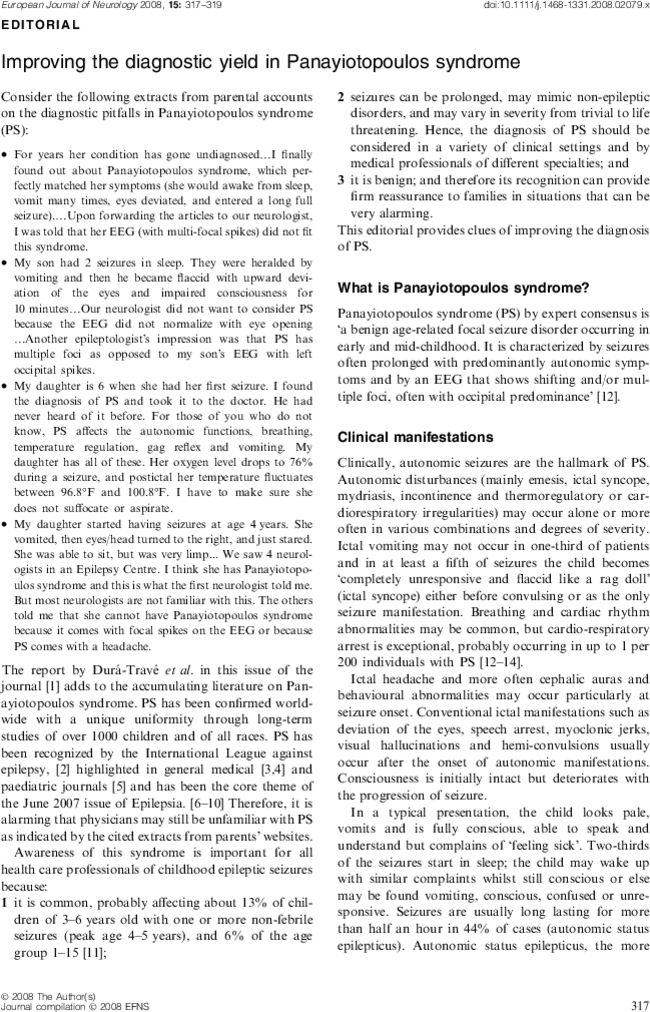Improving the diagnostic yield in Panayiotopoulos syndrome
A. Covanis,
C. P. Panayiotopoulos,
A. Covanis
Neurology Department, The Children Hospital “Agia Sophia”, Athens, Greece
Search for more papers by this authorC. P. Panayiotopoulos
Department of Clinical Neurophysiology and Epilepsies, St Thomas’ Hospital, London, UK
Search for more papers by this authorA. Covanis,
C. P. Panayiotopoulos,
A. Covanis
Neurology Department, The Children Hospital “Agia Sophia”, Athens, Greece
Search for more papers by this authorC. P. Panayiotopoulos
Department of Clinical Neurophysiology and Epilepsies, St Thomas’ Hospital, London, UK
Search for more papers by this author
References
- 1 Durá-Travé T, Yoldi-Petri ME, Gallinas-Victoriano F. Panayiotopoulos syndrome: epidemiological and clinical characteristics and outcome. European Journal of Neurology 2008; 15: 336–341.
- 2 Engel J Jr. Report of the ILAE classification core group. Epilepsia 2006; 47: 1558–1568.
- 3 Ferrie CD, Grunewald RA. Panayiotopoulos syndrome: a common and benign childhood epilepsy [Commentary]. Lancet 2001; 357: 821–823.
- 4 Koutroumanidis M. Panayiotopoulos syndrome: a common benign but underdiagnosed and unexplored early childhood seizure syndrome [Editorial]. BMJ 2002; 324: 1228–1229.
- 5 Covanis A. Panayiotopoulos Syndrome: a benign childhood autonomic epilepsy frequently imitating encephalitis, syncope, migraine, sleep disorder, or gastroenteritis. Pediatrics 2006; 118: e1237–e1243. (doi:10.1542/peds.2006-0623).
- 6 Panayiotopoulos CP. The birth and evolution of the concept of Panayiotopoulos syndrome. Epilepsia 2007; 48: 1041–1043.
- 7 Koutroumanidis M. Panayiotopoulos syndrome: an important electroclinical example of benign childhood system epilepsy. Epilepsia 2007; 48: 1044–1053.
- 8 Caraballo R, Cersosimo R, Fejerman N. Panayiotopoulos syndrome: a prospective study of 192 patients. Epilepsia 2007; 48: 1054–1061.
- 9 Ferrie CD, Caraballo R, Covanis A, et al. Autonomic status epilepticus in Panayiotopoulos syndrome and other childhood and adult epilepsies: a consensus view. Epilepsia 2007; 48: 1165–1172.
- 10 Martinovic Z. The new ILAE report on classification and evidence-based commentary on Panayiotopoulos syndrome and autonomic status epilepticus. Epilepsia 2007; 48: 1215–1216.
- 11 Panayiotopoulos CP. Panayiotopoulos Syndrome: A Common and Benign Childhood Epileptic Syndrome. London: John Libbey & Company, 2002.
- 12 Ferrie C, Caraballo R, Covanis A, et al. Panayiotopoulos syndrome: a consensus view. Developmental Medicine and Child Neurology 2006; 48: 236–240.
- 13 Verrotti A, Salladini C, Trotta D, Di Corcia G, Chiarelli F. Ictal cardiorespiratory arrest in Panayiotopoulos syndrome. Neurology 2005; 64: 1816–1817.
- 14 Panayiotopoulos CP. A Clinical Guide to Epileptic Syndromes and their Treatment, 2nd edn. London: Springer; 2007: 293–302.
- 15 Parisi P, Ferri R, Pagani J, Cecili M, Montemitro E, Villa MP. Ictal video-polysomnography and EEG spectral analysis in a child with severe Panayiotopoulos syndrome. Epileptic Disorders 2005; 7: 333–339.
- 16 Sanders S, Rowlinson S, Manidakis I, Ferrie CD, Koutroumanidis M. The contribution of the EEG technologists in the diagnosis of Panayiotopoulos syndrome (susceptibility to early onset benign childhood autonomic seizures). Seizure 2004; 13: 565–573.
- 17 Valeta T. Parental attitude and education in the management of childhood focal seizures. In: CP Panayiotopoulos eds. A Clinical Guide to Epileptic Syndromes and their Treatment, 2nd edn. London: Springer, 2007: 313–314.
- 18 Grosso S, Orrico A, Galli L, Di BR, Sorrentino V, Balestri P. SCN1A mutation associated with atypical Panayiotopoulos syndrome. Neurology 2007; 69: 609–611.




